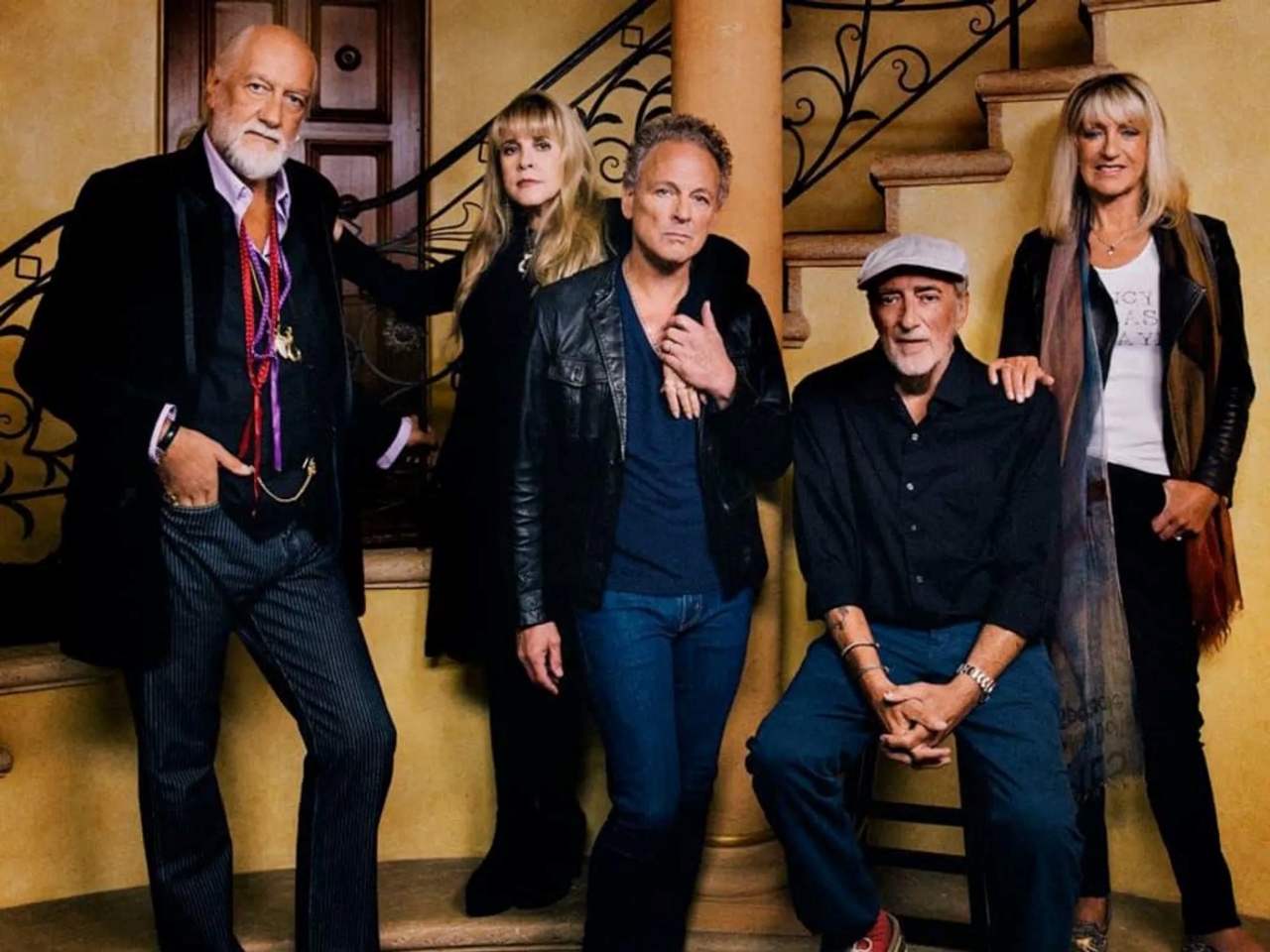🎸 The Birth of a Touring Machine (Late 1960s – Early 1970s)
Fleetwood Mac began as a British blues band in 1967, founded by guitarist Peter Green. In those early years, their tours were gritty, raw, and carried the unfiltered energy of the British blues explosion. Concerts in smoky clubs and small theaters saw Green’s guitar work mesmerize audiences, particularly with songs like “Albatross” and “Black Magic Woman.”
But by the early 1970s, the band’s lineup changes forced them to reinvent themselves again and again. Each tour became a new chapter, with members leaving, joining, and reshaping the band’s identity. By the time Stevie Nicks and Lindsey Buckingham joined in 1975, Fleetwood Mac were no longer just a blues act—they were on the verge of becoming one of the biggest touring rock bands on the planet.

💫 The Rumours Tour (1977–78) – Triumph Amid Turmoil
The Rumours Tour remains one of the most legendary in rock history. By then, the band had just released Rumours, an album born from heartbreak, betrayals, and fractured relationships. On stage, the tension was palpable—Stevie and Lindsey’s gazes told stories of love and war, Christine McVie played her heartbreak into soaring melodies, and Mick Fleetwood thundered on the drums like a man possessed.
Audiences were captivated not just by the music but by the drama unfolding in front of them. Each performance was electric, carrying the weight of personal turmoil transformed into collective catharsis. Songs like “Go Your Own Way” became more than hits—they were declarations shouted into stadiums, sung by thousands who felt the same pain.
The Rumours Tour solidified Fleetwood Mac as stadium rock royalty, proving they could pour chaos into timeless performances.
🌪️ Tusk Tour (1979–80) – The Brave Experiment Goes Global
If Rumours was polished perfection, Tusk was reckless daring. Lindsey Buckingham drove the band into new territory, and their live shows reflected that risk. The Tusk Tour was massive, spanning the U.S., Europe, and beyond.
Audiences witnessed a band both united and fractured. Buckingham’s eccentric energy often clashed with Nicks’ mystical aura, but that very friction created unforgettable performances. Stevie’s live renditions of “Sara” became legendary—intimate and vulnerable, sung as though she were bleeding on stage.
The Tusk Tour also became one of the first rock tours heavily documented on video, capturing the sheer scale of Fleetwood Mac’s global reach. They weren’t just a band anymore—they were a cultural phenomenon.
🌅 Mirage and the MTV Era (1982–83)
With Mirage, Fleetwood Mac embraced a softer sound, and their tours reflected that balance. The stage production became more polished, with visuals tailored for the rising MTV generation. Stevie, now fully stepping into her “White Witch” persona, would whirl in shawls, casting spells over stadium crowds.
The Mirage Tour also showed Fleetwood Mac adjusting to fame’s demands. The band had survived the Tusk backlash and personal turmoil, and now they were delivering a more accessible experience—still powerful, but less self-destructive.
🔥 Tango in the Night Tour (1987–88) – Without Lindsey
By 1987, Fleetwood Mac released Tango in the Night, one of their most commercially successful albums of the ’80s. But Lindsey Buckingham, exhausted by years of tension, decided not to tour. For the first time in a decade, the band faced the road without their crucial architect.
Still, the Tango Tour was a spectacle. Stevie, Christine, Mick, and John carried the legacy, with backup guitarists filling the void. Songs like “Little Lies” and “Everywhere” lit up arenas, proving that Fleetwood Mac’s magic extended beyond one member. Yet, fans could feel the absence—it was a reminder of the band’s fragility.
🌍 The Dance Reunion (1997) – A Phoenix Rising
If there was one tour that defined Fleetwood Mac’s enduring power, it was The Dance in 1997. Lindsey Buckingham returned. Christine McVie was still there. The “classic five” lineup—Mick, John, Christine, Stevie, Lindsey—were together again.
The MTV special and live album captured the moment: the band older, scarred, but utterly magnetic. Stevie and Lindsey sang “Silver Springs” face-to-face, decades of unresolved emotion pouring out in real time. It wasn’t just a performance—it was history unfolding before millions.
The tour was a triumph, proving that despite everything—addiction, heartbreak, and years apart—Fleetwood Mac could still rise like phoenixes when united.
🌙 Farewell Chapters – The Later Tours (2000s–2010s)
In the 2000s and 2010s, Fleetwood Mac continued touring, often without Christine McVie, who had retired in 1998. The tours leaned heavily on Stevie’s charisma and Lindsey’s restless energy. Audiences packed arenas to hear “Dreams,” “The Chain,” and “Landslide.”
When Christine rejoined in 2014, fans rejoiced. The On With the Show Tour brought back the full magic—three distinct voices weaving into that unmistakable Fleetwood Mac sound. Every performance of “Songbird” felt like a blessing, Christine’s voice carrying gentle grace across stadiums.
Even when Buckingham was later fired in 2018, replaced by Neil Finn and Mike Campbell, Fleetwood Mac kept touring. Their story was proof: no matter the lineup, their music had become larger than any single member.
🕊️ The Eternal Connection Between Stage and Audience
Across the decades, what made Fleetwood Mac’s tours legendary wasn’t just the music—it was the raw human drama that audiences could feel. Fans didn’t just watch concerts; they witnessed lives unfolding in song.
From the heartbreak of Rumours to the reunion of The Dance, from Stevie’s spinning shawls to Mick Fleetwood’s pounding heartbeat, every tour carried the scars, joys, and resilience of survival.
Fleetwood Mac’s concerts weren’t perfect. They were messy, emotional, sometimes chaotic—but that’s why they mattered. Because inside that mess was truth, and truth always resonates louder than perfection.
.